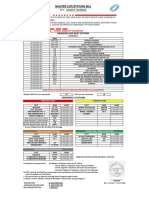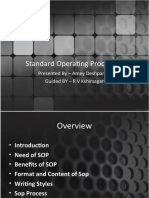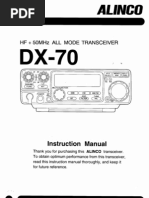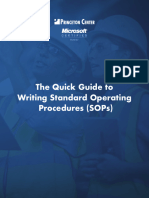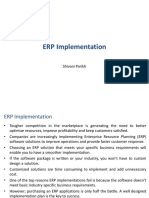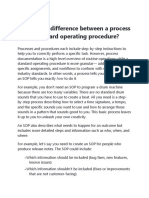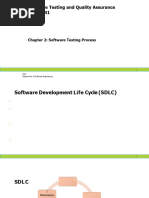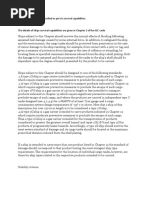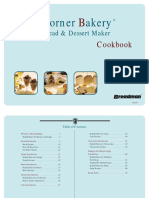0 ratings0% found this document useful (0 votes)
97 viewsSOP - STD Operating Procedures
SOP - STD Operating Procedures
Uploaded by
sidadams2Standard operating procedures (SOPs) are written documents that describe work processes and provide step-by-step instructions to help employees complete tasks correctly and consistently. SOPs help reduce training time for new employees by providing instructions, ensure continuity when employees leave, and allow processes to be completed consistently even when personnel change. Developing high-quality SOPs involves gathering relevant stakeholders, outlining the purpose and scope, testing the procedures, and reviewing and revising the documents periodically.
Copyright:
© All Rights Reserved
Available Formats
Download as PPTX, PDF, TXT or read online from Scribd
SOP - STD Operating Procedures
SOP - STD Operating Procedures
Uploaded by
sidadams20 ratings0% found this document useful (0 votes)
97 views27 pagesStandard operating procedures (SOPs) are written documents that describe work processes and provide step-by-step instructions to help employees complete tasks correctly and consistently. SOPs help reduce training time for new employees by providing instructions, ensure continuity when employees leave, and allow processes to be completed consistently even when personnel change. Developing high-quality SOPs involves gathering relevant stakeholders, outlining the purpose and scope, testing the procedures, and reviewing and revising the documents periodically.
Original Title
SOP_Std Operating Procedures
Copyright
© © All Rights Reserved
Available Formats
PPTX, PDF, TXT or read online from Scribd
Share this document
Did you find this document useful?
Is this content inappropriate?
Standard operating procedures (SOPs) are written documents that describe work processes and provide step-by-step instructions to help employees complete tasks correctly and consistently. SOPs help reduce training time for new employees by providing instructions, ensure continuity when employees leave, and allow processes to be completed consistently even when personnel change. Developing high-quality SOPs involves gathering relevant stakeholders, outlining the purpose and scope, testing the procedures, and reviewing and revising the documents periodically.
Copyright:
© All Rights Reserved
Available Formats
Download as PPTX, PDF, TXT or read online from Scribd
Download as pptx, pdf, or txt
0 ratings0% found this document useful (0 votes)
97 views27 pagesSOP - STD Operating Procedures
SOP - STD Operating Procedures
Uploaded by
sidadams2Standard operating procedures (SOPs) are written documents that describe work processes and provide step-by-step instructions to help employees complete tasks correctly and consistently. SOPs help reduce training time for new employees by providing instructions, ensure continuity when employees leave, and allow processes to be completed consistently even when personnel change. Developing high-quality SOPs involves gathering relevant stakeholders, outlining the purpose and scope, testing the procedures, and reviewing and revising the documents periodically.
Copyright:
© All Rights Reserved
Available Formats
Download as PPTX, PDF, TXT or read online from Scribd
Download as pptx, pdf, or txt
You are on page 1of 27
SOP
•Standard operating procedures.
•How things are going to be
done.
•What to do?
•Who will do?
•Best way to do?.
SOP
•When you add a new employee to
your company or a new member to
your team, you can't expect them
to know everything from day one.
•And although you should certainly
take the time to train them, time is
always in short supply for training.
SOP
•That is why companies of all sizes
develop standard operating
procedures, or SOPs.
•These crucial process documents contain
necessary instructions on how to complete
critical processes or tasks in a company.
•Writing standard operating procedures
ensure that a company can keep running
smoothly as employees come and go.
SOP
•An SOP, or Standard Operating
Procedure, is merely a
documentation of how a process
works.
•SOPs work best as a step-by-step
list of procedures that anyone can
follow with a bit of training.
SOP
•Companies develop SOPs for a
variety of reasons.
•One of these is that SOPs help
reduce the training time for new
team members.
•Hand them a well-built SOP, and
they'll have a considerable head
start on completing the task at hand.
SOP
•the first point of introduction for new team
members.
• ensures continuity
•If someone who was crucial to the
team's success because of his
knowledge and experience leaves the
company,
•the process breaks down and can't be
completed.
SOP
•The master, officers, & crew of a
ship changes frequently
•But the ship does not stop running.
•New persons joining use the
procedures laid down and adapt
quickly & keep the ship running.
•Legal protection
SOP
•if you don't have a process documented,
•you don't have a process.
•You've got some steps that you
sometimes perform haphazardly.
•Standard operating procedures are just
that –
•standardized.
•They can be handed off to others without
the process breaking down.
SOP
•Enclosed space entry procedures.
•Hot work procedures.
•Procedure for overhauling main
engine.
•Tank cleaning procedure.
•Ship to ship transfer procedures
•Dry docking procedures
SOP
•Writing a SOP: (16 steps)
•1. How to present the SOP:
•Simple and easy
•Format
•Use ISO standards
•Template
SOP
•2. Gather relevant stakeholders:
•Use people who will be
responsible for the task
•Who has done these tasks before.
•More expertise & scrutiny
•Feels ownership
SOP
•3. what is the purpose?
•What do you want to achieve?
•New procedure?
•Improve already implemented
procedure?
•What was lacking in old procedure
SOP
•4. structure of the SOP?
•Where does this procedure
come in?
•The process before & after this.
•How often?
•Align with other
documentation
SOP
•5. scope of the procedure?
•Prevents wandering off to other
procedures
•WHY?
•What initiates this?
•What finishes this?
SOP
•6. use a consistent style:
•Familiar style
•Simple style
•Scannable,
•Printable
•Use action verbs
•Be concise
SOP
•7. use correct notation:
•For analysis later
•Data collection
•Standard format
SOP
•8. work out necessary steps:
•The main part
•Step by step
•Practical
•Sub tasks if required
•Easy to follow
SOP
•9. assess potential problems:
•What can go wrong
•Where can it go wrong
•Any changes required
SOP
•10. determine metrics against
which the SOP can be judged:
•Data analysis metrics
•Measurable
SOP
•11. test the process:
•Moment of truth
•Dry run
•Persons who have nothing to
do with it.
SOP
•12. send for acceptance to
superiors:
•Quality system requirements
•Checked by, Verified by, Approved
by, Version no
•Experience and expenditure.
•Legally acceptable.
SOP
•13. method of optimizing the
process:
•Next review date
•Validation
SOP
•14. run a risk assessment:
•Security of the document
•Interrelation with other processes
•Interrelation with other
departments
•Safety & environment protection
priority over speed
SOP
•15. create a flow diagram:
•Useful
•Easy to understand
•Easy tofollow
SOP
•16. finalize & implement:
•Congrats!
•End of the making process
•Put into use
•Followed by
SOP
•Storage:
•Where under whom
•Who has access
•Who has authority to change
•obsolete documents control
SOP
•Review & revision:
•While in use take feedback
•Need improvement make changes
•Other changes that will affect this
•Make change
You might also like
- 9781003384779_previewpdf (1)Document80 pages9781003384779_previewpdf (1)ahmad.samir0% (1)
- Pokemon 5e - Gen I & II Monster ManualDocument127 pagesPokemon 5e - Gen I & II Monster ManualAlberto Cappelli80% (10)
- Diy Tempering ChocolateDocument2 pagesDiy Tempering Chocolatesb7994283No ratings yet
- Research Progress On Pipeline Transportation Technology of Hydrogen-Mixed Natural GasDocument11 pagesResearch Progress On Pipeline Transportation Technology of Hydrogen-Mixed Natural GaschaimaleghNo ratings yet
- Software Requirement and Design Specification (SRDS)Document7 pagesSoftware Requirement and Design Specification (SRDS)Sardar RaziullahNo ratings yet
- Sop 4Document1 pageSop 4Naveed AkhterNo ratings yet
- List of Statutory CertificatesDocument3 pagesList of Statutory Certificatessidadams2100% (7)
- Muster List PrintableDocument1 pageMuster List Printablesidadams250% (4)
- The Wirecard Accounting Scandal in Germany, and How The Financial Industry Failed To Spot ItDocument28 pagesThe Wirecard Accounting Scandal in Germany, and How The Financial Industry Failed To Spot ItJuliette DemeyNo ratings yet
- Standard Operating Procedure: Presented by - Amey Deshpande Guided BY - R V KshirsagarDocument22 pagesStandard Operating Procedure: Presented by - Amey Deshpande Guided BY - R V Kshirsagaramey_dpd100% (1)
- Humphrey Managing The Software ProcessDocument32 pagesHumphrey Managing The Software ProcessappasamiNo ratings yet
- Alinco DX-70 Instruction ManualDocument98 pagesAlinco DX-70 Instruction ManualYayok S. Anggoro100% (5)
- Mass Communications Entrance Exams - Important Practice Questions Part 1Document4 pagesMass Communications Entrance Exams - Important Practice Questions Part 1kewal1829No ratings yet
- New Eco Ink MsdsDocument7 pagesNew Eco Ink MsdsankitleedsNo ratings yet
- Final Scaling SOPDocument12 pagesFinal Scaling SOPBilal Al AliNo ratings yet
- Sales and Marketing Sample PBIXDocument6 pagesSales and Marketing Sample PBIXEvandro Fernandes LedemaNo ratings yet
- Standard Operating Procedure of Fluidized Bed DryerDocument4 pagesStandard Operating Procedure of Fluidized Bed DryerSolomonNo ratings yet
- Logic Description: DCMA 14-Point Assessment MetricsDocument4 pagesLogic Description: DCMA 14-Point Assessment MetricsOsamaNo ratings yet
- DSF Agency SELL MORE KITCHENS BATHROOMSDocument24 pagesDSF Agency SELL MORE KITCHENS BATHROOMSMurray AlexanderNo ratings yet
- Nader Agile CVDocument6 pagesNader Agile CVEbookintheplaceNo ratings yet
- Inventory For Fixed Asset TransferDocument24 pagesInventory For Fixed Asset TransferGaphur shaikNo ratings yet
- Standard Operating Procedure (SOP) TTT PUne 2019Document15 pagesStandard Operating Procedure (SOP) TTT PUne 2019Prajyesh Kr YadavNo ratings yet
- SAP S4 Hana ABAP Training Contents and ScheduleDocument3 pagesSAP S4 Hana ABAP Training Contents and ScheduleSapience ConsultingNo ratings yet
- The Ultimate Client Attraction System For Service Based Business Owners PDFDocument17 pagesThe Ultimate Client Attraction System For Service Based Business Owners PDFDonald VooNo ratings yet
- Standard Operating Procedures (SOPs)Document19 pagesStandard Operating Procedures (SOPs)Raunaq SinghNo ratings yet
- FTC 93 - SOP and SSOPDocument7 pagesFTC 93 - SOP and SSOPAPRILLE ANN ORCULLO MALLARINo ratings yet
- ITHS SOPs for Clinical Research 03-03-10Document34 pagesITHS SOPs for Clinical Research 03-03-10Mark john austriaNo ratings yet
- Princeton Center Guide To Writing Standard Operating ProceduresDocument18 pagesPrinceton Center Guide To Writing Standard Operating ProceduresTrue GeminiNo ratings yet
- Test Vs Inspection 2Document40 pagesTest Vs Inspection 2gaspardo123No ratings yet
- SOPs Writing EssentialsDocument12 pagesSOPs Writing Essentialsniteshramjee5No ratings yet
- Test Versus Inspection: Tor StålhaneDocument40 pagesTest Versus Inspection: Tor Stålhanegaspardo123No ratings yet
- Case Study: 5S Organization of A College Test LabDocument37 pagesCase Study: 5S Organization of A College Test Labadak avijitNo ratings yet
- 8 Standard WorkDocument35 pages8 Standard Workالبراء عسيريNo ratings yet
- Standard Operating ProceduresDocument29 pagesStandard Operating Proceduresarsalankhan8626No ratings yet
- ISO 9000 Implementation Tips & TechniquesDocument5 pagesISO 9000 Implementation Tips & TechniquessnaireNo ratings yet
- SOP's: The 5 W's and One HDocument24 pagesSOP's: The 5 W's and One HSudheer AyazNo ratings yet
- System Life Cycle For IGCSE 2020Document8 pagesSystem Life Cycle For IGCSE 2020HikmaNo ratings yet
- Lean Kaizen Event - Project Management PerspectiveDocument48 pagesLean Kaizen Event - Project Management PerspectiveinvencaodemorelNo ratings yet
- Purchasing ROCME TrainingDocument28 pagesPurchasing ROCME TrainingJoeNo ratings yet
- 5S' Manual: 5S Is The Name of A Workplace Organization Methodology That Uses ADocument20 pages5S' Manual: 5S Is The Name of A Workplace Organization Methodology That Uses Aefl731022100% (2)
- Lec # 5 Development of Standard Operating Procedures for a ClinicalDocument18 pagesLec # 5 Development of Standard Operating Procedures for a ClinicalAbubakar ImranNo ratings yet
- ERP ImplementationDocument16 pagesERP ImplementationSharon DsouzaNo ratings yet
- Establishing and Managing A Continuous Process Improvement ProgramDocument49 pagesEstablishing and Managing A Continuous Process Improvement ProgramgezeNo ratings yet
- Sop 5Document12 pagesSop 5Naveed AkhterNo ratings yet
- Introduction To Internal AuditsDocument27 pagesIntroduction To Internal AuditsqidohsNo ratings yet
- Introduction To Internal AuditsDocument25 pagesIntroduction To Internal Auditstheresia.alamNo ratings yet
- FIS Chapter 4Document27 pagesFIS Chapter 4hagehanko621No ratings yet
- R12 Upgrade Approach and Lessons Learned: Brian Pellot, AXIA ConsultingDocument22 pagesR12 Upgrade Approach and Lessons Learned: Brian Pellot, AXIA ConsultingChuka OsemekaNo ratings yet
- Chapter 6Document28 pagesChapter 6abelteshome56No ratings yet
- Internal Audit PresentationDocument22 pagesInternal Audit PresentationwgseafoodklNo ratings yet
- General Employee Training Presentation ISO 9001 - v2Document61 pagesGeneral Employee Training Presentation ISO 9001 - v2melkamu tesfayeNo ratings yet
- Chapter 6 Implementation of Information systemsDocument33 pagesChapter 6 Implementation of Information systemsdarlami939No ratings yet
- 12.9 - PPP Training - Dallas - Dec 2019 - For PostingDocument70 pages12.9 - PPP Training - Dallas - Dec 2019 - For PostingfayrouzmohammedmohammedNo ratings yet
- 5S and Kaizen PDFDocument28 pages5S and Kaizen PDFShinta Nugraha Mughni100% (2)
- 5s and KaizenDocument28 pages5s and KaizenSatya KumarNo ratings yet
- Chapter 5Document27 pagesChapter 5abelteshome56No ratings yet
- Process Improvement For Any Business: Presented by Scott A. SilvermanDocument43 pagesProcess Improvement For Any Business: Presented by Scott A. SilvermanNavnath TamhaneNo ratings yet
- Basic Software Engineering: Prof. Vijya Tulsani, Assistant ProfessorDocument28 pagesBasic Software Engineering: Prof. Vijya Tulsani, Assistant ProfessorKuldeep ParekhNo ratings yet
- 8 Wastes 1228325060915904 9Document28 pages8 Wastes 1228325060915904 9Denuj jouNo ratings yet
- 5SDocument29 pages5Sshweta.gdp100% (10)
- Systems Development Life CycleDocument21 pagesSystems Development Life Cyclejamb2316No ratings yet
- Standard Operating Procedures Sop: Preparation, Implementation and Maintenance of SopsDocument11 pagesStandard Operating Procedures Sop: Preparation, Implementation and Maintenance of SopsMwakap MwakaNo ratings yet
- Chapter 2 Software Testing ProcessDocument37 pagesChapter 2 Software Testing ProcessDani AberaNo ratings yet
- Requirements Elicitation: Requirement TechniquesDocument59 pagesRequirements Elicitation: Requirement TechniquesmurthysejrNo ratings yet
- Om Process AnalysisDocument13 pagesOm Process AnalysisBrein Symon DialaNo ratings yet
- Sop ProcedureDocument22 pagesSop Procedurehoraspanjaitan99No ratings yet
- ProceduresDocument23 pagesProceduresUmair HameedNo ratings yet
- Muara Satui 12/22/2015: Heights Are in Meters Above Chart Datum Times Are in Local TimeDocument45 pagesMuara Satui 12/22/2015: Heights Are in Meters Above Chart Datum Times Are in Local Timesidadams2No ratings yet
- UntitledDocument6 pagesUntitledsidadams2No ratings yet
- Corrigendum - GMDSSDocument1 pageCorrigendum - GMDSSsidadams2No ratings yet
- DGS EXAM Circular No.13 of 2022 - Clarilication Regarding Booking and Appearing in Competencv Exam - Dated16june2022Document3 pagesDGS EXAM Circular No.13 of 2022 - Clarilication Regarding Booking and Appearing in Competencv Exam - Dated16june2022sidadams2100% (1)
- Working Aloft Risk AssessmentDocument2 pagesWorking Aloft Risk Assessmentsidadams2100% (2)
- Cloudwise LeftDocument1 pageCloudwise Leftsidadams2No ratings yet
- How Gas Carriers Are Classified As Per Its Survival CapabilitiesDocument6 pagesHow Gas Carriers Are Classified As Per Its Survival Capabilitiessidadams2No ratings yet
- Code of Safe Working Practices: Objectives & ContentsDocument8 pagesCode of Safe Working Practices: Objectives & Contentssidadams2100% (1)
- Surveys & HSSCDocument14 pagesSurveys & HSSCsidadams2No ratings yet
- DGS MSnotice08of2022dated20-07-2022 2nd Mate FG Equivalent To BSC NSDocument2 pagesDGS MSnotice08of2022dated20-07-2022 2nd Mate FG Equivalent To BSC NSsidadams2No ratings yet
- Docking Survey Checklist: Form No.: CL-DS (Rev.03) Page 1 of 3Document3 pagesDocking Survey Checklist: Form No.: CL-DS (Rev.03) Page 1 of 3sidadams2100% (1)
- Checklist For The Renewalsurvey of Ship Radio CertificateDocument7 pagesChecklist For The Renewalsurvey of Ship Radio Certificatesidadams2No ratings yet
- The Esp Code - Introduction What Is Enhanced Survey Programme?Document7 pagesThe Esp Code - Introduction What Is Enhanced Survey Programme?sidadams2100% (1)
- Amendments To The LSA CodeDocument2 pagesAmendments To The LSA Codesidadams2No ratings yet
- Annex 2 Drill Matrix Dry Cargo Vessels: Frequency Contingency/ EmergencyDocument9 pagesAnnex 2 Drill Matrix Dry Cargo Vessels: Frequency Contingency/ Emergencysidadams2No ratings yet
- Maintainence of Lsa EquipmentDocument5 pagesMaintainence of Lsa Equipmentsidadams2No ratings yet
- Agenda: Safety Committee Meeting Agenda and MinutesDocument2 pagesAgenda: Safety Committee Meeting Agenda and Minutessidadams2No ratings yet
- VtsDocument16 pagesVtssidadams2No ratings yet
- Chief Mate MMD Assesment - ChecklistDocument1 pageChief Mate MMD Assesment - Checklistsidadams2No ratings yet
- LSACODEDocument44 pagesLSACODEsidadams2No ratings yet
- Air Mass + Frontal DepressionDocument14 pagesAir Mass + Frontal Depressionsidadams2No ratings yet
- Tide - Harmonic Constant MethodDocument1 pageTide - Harmonic Constant Methodsidadams2No ratings yet
- 14-Nt (09) /2008 Dated: 29Th January, 2009Document2 pages14-Nt (09) /2008 Dated: 29Th January, 2009sidadams2No ratings yet
- CSS Code 2011Document73 pagesCSS Code 2011sidadams2No ratings yet
- Final ReportDocument71 pagesFinal Reportapi-580060021No ratings yet
- Catalogue Interrupteur Fusible PDFDocument116 pagesCatalogue Interrupteur Fusible PDFchahbounnabilNo ratings yet
- Lab Report 4Document6 pagesLab Report 4api-340581896No ratings yet
- Background of TDocument2 pagesBackground of Telias ferhanNo ratings yet
- Uberman: Almost Super Human: Techniques For Unlocking Ultimate Human PotentialDocument90 pagesUberman: Almost Super Human: Techniques For Unlocking Ultimate Human PotentialSameer AhmedNo ratings yet
- Public Health Project ManagementDocument62 pagesPublic Health Project ManagementDhan lal pandeyNo ratings yet
- JSL Jajpur-1975Document3 pagesJSL Jajpur-1975Roshan JhaNo ratings yet
- Lecture 13Document37 pagesLecture 13edurazee7452No ratings yet
- A Sunshine InitiativeDocument18 pagesA Sunshine Initiativemanu nairNo ratings yet
- Omawumi - Wonder WomanDocument3 pagesOmawumi - Wonder WomanOye AkideindeNo ratings yet
- 2000 Packet HandbookDocument58 pages2000 Packet HandbookKenburNo ratings yet
- Columbia UniversityDocument11 pagesColumbia UniversityДарья ЛесикNo ratings yet
- PumpsDocument31 pagesPumpsOsamaNo ratings yet
- Notes Unit 1 Technical CommunicationDocument12 pagesNotes Unit 1 Technical CommunicationDev KumarNo ratings yet
- Crime Scene Do Not Cross Crime Scene Do Not CrossDocument27 pagesCrime Scene Do Not Cross Crime Scene Do Not CrossSave LossNo ratings yet
- Evaluation of Essential Oil Components From The Fruit Peelings of Sindhri and Langra Varieties of Mango (Mangifera Indica L.)Document6 pagesEvaluation of Essential Oil Components From The Fruit Peelings of Sindhri and Langra Varieties of Mango (Mangifera Indica L.)Ketema BeyechaNo ratings yet
- Nis GuideDocument8 pagesNis Guidekovu737No ratings yet
- Security Threats and MechanismsDocument10 pagesSecurity Threats and Mechanismsmirajadhi007No ratings yet
- The Similarity Principle - On Using Models CorrectlyDocument4 pagesThe Similarity Principle - On Using Models CorrectlyDhanraj BachaiNo ratings yet
- CS 303e, Assignment #10: Practice Reading and Fixing Code Due: Sunday, April 14, 2019 Points: 20Document2 pagesCS 303e, Assignment #10: Practice Reading and Fixing Code Due: Sunday, April 14, 2019 Points: 20Anonymous pZ2FXUycNo ratings yet
- Bread Recipes PDFDocument72 pagesBread Recipes PDFAnfy CeninaNo ratings yet
- Scales, Chords & Arpeggios - Bastien, James W - San Diego, CA, 1988 - San Diego, Calif. - Niel A. Kjos Music Co. - 9780849793516 - Anna's ArchiveDocument44 pagesScales, Chords & Arpeggios - Bastien, James W - San Diego, CA, 1988 - San Diego, Calif. - Niel A. Kjos Music Co. - 9780849793516 - Anna's Archivecraftycow62No ratings yet
- Percent ConvertDocument2 pagesPercent Convertapi-350074596No ratings yet
- Manual Change History: Date Section Procedure Number Procedure Title Update ReasonDocument37 pagesManual Change History: Date Section Procedure Number Procedure Title Update ReasoninterloNo ratings yet







